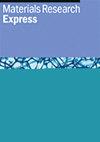Evaluation of wear resistance of CrN, CrAlN, and TiAlN coatings deposited by multi-arc ion plating on spinning die of Cr12MoV
IF 2.2
4区 材料科学
Q3 MATERIALS SCIENCE, MULTIDISCIPLINARY
引用次数: 0
Abstract
This study successfully deposited CrN, CrAlN, and TiAlN coatings on the surface of Cr12MoV substrate using multi-arc ion plating (MAIP). The influence of phase composition and surface morphology on the hardness, adhesion strength, friction performance, and wear mechanisms of these coatings was investigated, with a comparative analysis of their wear resistance. Nanoindentation results revealed that the hardness (H) of CrN, CrAlN, and TiAlN coatings increased by 70.37%, 74.97%, and 75.64%, respectively, compared to the substrate. The hardness (H) and elastic modulus (E) were found to be positively correlated. CrAlN demonstrated superior resistance to deformation, reflected in its higher H/E and H3/E2 radios compared to the CrN and TiAlN. Adhesion tests showed that CrAlN had the strongest adhesion strength to the substrate, with an adhesion force of 81.55 N, representing a 14.78% and 8.46% improvement over CrN and TiAlN, respectively. Friction and wear tests identified CrAlN as having the lowest friction coefficient (0.389), attributed to its high hardness and strong adhesion. The wear mechanisms of CrAlN observed were primarily mild abrasive wear, oxidative wear, and adhesive wear. In comparison, CrN and TiAlN coatings exhibited higher friction coefficients of 0.424 and 0.391, respectively, due to their lower hardness and adhesion, which led to more severe oxidative and abrasive wear. Additionally, the TiAlN coating showed signs of brittle failure in wear scars, likely due to the formation of Al2O3 oxides during wear.通过多弧离子镀沉积在 Cr12MoV 纺丝模上的 CrN、CrAlN 和 TiAlN 涂层的耐磨性评估
本研究利用多弧离子镀(MAIP)技术在 Cr12MoV 基体表面成功沉积了 CrN、CrAlN 和 TiAlN 涂层。研究了相组成和表面形貌对这些涂层的硬度、附着强度、摩擦性能和磨损机理的影响,并对它们的耐磨性进行了比较分析。纳米压痕结果显示,与基体相比,CrN、CrAlN 和 TiAlN 涂层的硬度(H)分别提高了 70.37%、74.97% 和 75.64%。硬度 (H) 和弹性模量 (E) 呈正相关。与 CrN 和 TiAlN 相比,CrAlN 的 H/E 和 H3/E2 辐射更高,这反映了 CrAlN 具有更强的抗变形能力。附着力测试表明,CrAlN 与基体的附着力最强,附着力为 81.55 N,分别比 CrN 和 TiAlN 提高了 14.78% 和 8.46%。摩擦和磨损测试表明,CrAlN 的摩擦系数(0.389)最低,这归功于它的高硬度和强附着力。所观察到的 CrAlN 磨损机制主要是轻度磨料磨损、氧化磨损和粘着磨损。相比之下,CrN 和 TiAlN 涂层的摩擦系数较高,分别为 0.424 和 0.391,这是因为它们的硬度和附着力较低,导致了更严重的氧化磨损和磨料磨损。此外,TiAlN 涂层在磨损疤痕中显示出脆性破坏的迹象,这可能是由于在磨损过程中形成了 Al2O3 氧化物。
本文章由计算机程序翻译,如有差异,请以英文原文为准。
求助全文
约1分钟内获得全文
求助全文
来源期刊

Materials Research Express
MATERIALS SCIENCE, MULTIDISCIPLINARY-
CiteScore
4.50
自引率
4.30%
发文量
640
审稿时长
12 weeks
期刊介绍:
A broad, rapid peer-review journal publishing new experimental and theoretical research on the design, fabrication, properties and applications of all classes of materials.
 求助内容:
求助内容: 应助结果提醒方式:
应助结果提醒方式:


